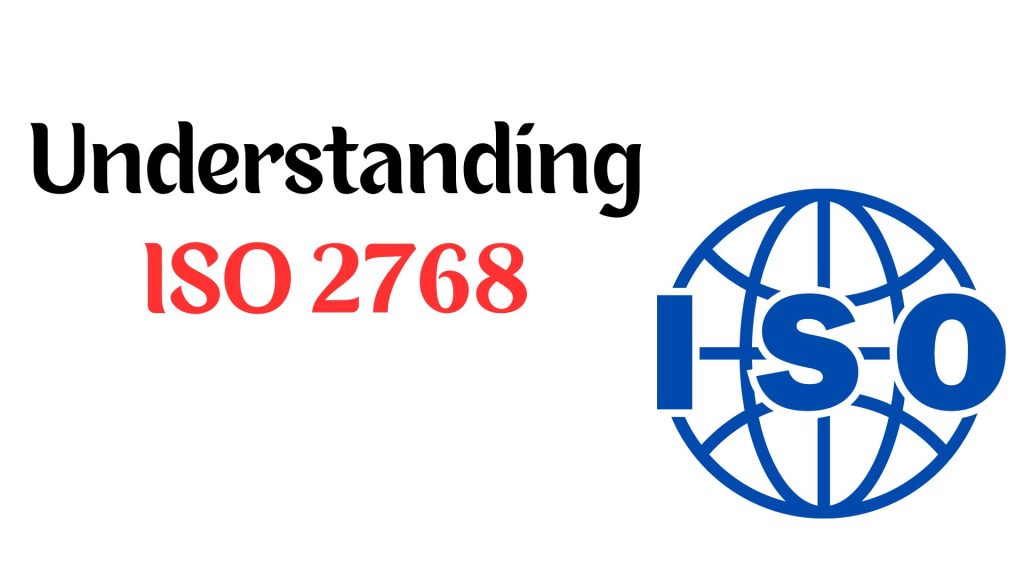Every feature on a product or part has a size and a geometric shape. To ensure that the size and geometry of all features are made as required, we should pay careful attention to the tolerances on the drawing. Nothing should be implied or left to interpretation in the shop or inspection department. General tolerances for size and geometry make it easier to ensure that the size and geometry of all features can be made as required.
What is ISO 2768?
The ISO 2768 series of standards was developed by the International Organization for Standardization to provide general tolerances for linear and angular dimensions without individual tolerance specifications on engineering drawings. Since individual tolerances aren’t provided, the designer must ensure that products manufactured to the drawings will function properly.
What does ISO 2768-mK mean?
ISO 2768-mK means that the dimensional information for which the tolerances are not specified is followed according to the m and K classes. The m class is specified in ISO 2768-1, and the K class is specified in ISO 2768-2, which includes H, K, and L tolerance levels.
The following is a summary of the ISO 2768-1 and ISO 2768-2 specifications:
1 General Tolerances ISO 2768-1
ISO 2768-1 stands for the general tolerances for linear and angular dimensions without individual tolerance specifications, ISO 2768-1 specifies the linear and angular dimensions such as outside dimensions, inside dimensions, step sizes, diameters, radii, distances, outside radii, and chamfer heights for broken edges. This standard covers general tolerances in three 4 tolerance classes:
M – Medium Tolerances
F – Fine tolerances
C – Coarse tolerances
V – Very coarse tolerances
Table 1 – Linear Dimensions
| Permissible deviations in mm for ranges in nominal lengths | Tolerance Class Designation (Description) | |||
|---|---|---|---|---|
| f (fine) | m (medium) | c (coarse) | v (very coarse) | |
| 0.5 up to 3 | ±0.05 | ±0.1 | ±0.2 | – |
| over 3 up to 6 | ±0.05 | ±0.1 | ±0.3 | ±0.5 |
| over 6 up to 30 | ±0.1 | ±0.2 | ±0.5 | ±1.0 |
| over 30 up to 120 | ±0.15 | ±0.3 | ±0.8 | ±1.5 |
| over 120 up to 400 | ±0.2 | ±0.5 | ±1.2 | ±2.5 |
| over 400 up to 1000 | ±0.3 | ±0.8 | ±2.0 | ±4.0 |
| over 1000 up to 2000 | ±0.5 | ±1.2 | ±3.0 | ±6.0 |
| over 2000 up to 4000 | – | ±2.0 | ±4.0 | ±8.0 |
Table 2 – External Radii and Chamfer Heights
| Permissible deviations in mm for ranges in nominal lengths | Tolerance Class Designation (Description) | |||
|---|---|---|---|---|
| f (fine) | m (medium) | c (coarse) | v (very coarse) | |
| 0.5 up to 3 | ±0.2 | ±0.2 | ±0.4 | ±0.4 |
| over 3 up to 6 | ±0.5 | ±0.5 | ±1.0 | ±1.0 |
| over 6 | ±1.0 | ±1.0 | ±2.0 | ±2.0 |
Table 3 – Angular Dimensions
| Permissible deviations in mm for ranges in nominal lengths | Tolerance Class Designation (Description) | |||
|---|---|---|---|---|
| f (fine) | m (medium) | c (coarse) | v (very coarse) | |
| up to 10 | ±1º | ±1º | ±1º30′ | ±3º |
| over 10 up to 50 | ±0º30′ | ±0º30′ | ±1º | ±2º |
| over 50 up to 120 | ±0º20′ | ±0º20′ | ±0º30′ | ±1º |
| over 120 up to 400 | ±0º10′ | ±0º10′ | ±0º15′ | ±0º30′ |
| over 400 | ±0º5′ | ±0º5′ | ±0º10′ | ±0º20′ |
#2 General Tolerances ISO 2768-2
ISO 2768-2 stands for the geometrical tolerances for features without individual tolerance indications. It indicates the general geometrical tolerances range of flatness & straightness, cylindricity, and circularity. This standard includes 3 classes of tolerance – H, K, and L:
Table 4 – General Tolerances on Straightness and Flatness
| Ranges of nominal lengths in mm | Tolerance Class | ||
|---|---|---|---|
| H | K | L | |
| up to 10 | 0.02 | 0.05 | 0.1 |
| above 10 to 30 | 0.05 | 0.1 | 0.2 |
| above 30 to 100 | 0.1 | 0.2 | 0.4 |
| above 100 to 300 | 0.2 | 0.4 | 0.8 |
| above 300 to 1000 | 0.3 | 0.6 | 1.2 |
| above 1000 to 3000 | 0.4 | 0.8 | 1.6 |
Table 5 – General Tolerances on Perpendicularity
| Ranges of nominal lengths in mm | Tolerance Class | ||
|---|---|---|---|
| H | K | L | |
| up to 100 | 0.2 | 0.4 | 0.6 |
| above 100 to 300 | 0.3 | 0.6 | 1.0 |
| above 300 to 1000 | 0.4 | 0.8 | 1.5 |
| above 1000 to 3000 | 0.5 | 1.0 | 2.0 |
Table 6 – General Tolerances on Symmetry
| Ranges of nominal lengths in mm | Tolerance Class | ||
|---|---|---|---|
| H | K | L | |
| up to 100 | 0.5 | 0.6 | 0.6 |
| above 100 to 300 | 0.5 | 0.6 | 1.0 |
| above 300 to 1000 | 0.5 | 0.8 | 1.5 |
| above 1000 to 3000 | 0.5 | 1.0 | 2.0 |
Table 7 – General Tolerances on Circular Run-Out
| Ranges of nominal lengths in mm | Tolerance Class | ||
|---|---|---|---|
| H | K | L | |
| 0.1 | 0.2 | 0.5 | |
This general tolerance allows the manufacturer to choose the appropriate tolerance level that suits their needs best. For example, if the part is expected to be used in a project with high-level tolerance requirements, it would be wise to choose a small tolerance range. On the contrary, a larger tolerance range would be more cost-effective if the part is produced in high volumes for lower-level tolerance applications.
conclusion
The level of tolerance required for a part depends on how it will be used and the requirements of the application. Factors such as materials, processes and cost should also be considered when determining the right level of tolerance for a part or product. For example, if you need a precise metal part with tight tolerances for your project, CNC machining is a good choice. CNC machines are highly accurate and can produce parts with very tight tolerances, typically CNC machining tolerances can range from ±0.001″ to ±0.0001″.
Disclaimer of Warranty
The contents of this website are provided for informational purposes only. MY Prototyping makes no representations or warranties of any kind, express or implied, as to the accuracy, completeness or validity of the information. Any performance parameters, geometric tolerances, specific design features, quality and types of materials, or processes should not be inferred to represent what will be supplied by third party suppliers or manufacturers through MY Prototyping’s network. Buyers seeking instant quotes for parts are responsible for defining the specific requirements for those parts. Please see our Terms and Conditions for more information.
Related Reference
Toleranztabellen nach ISO 2768 – Wikipedia






